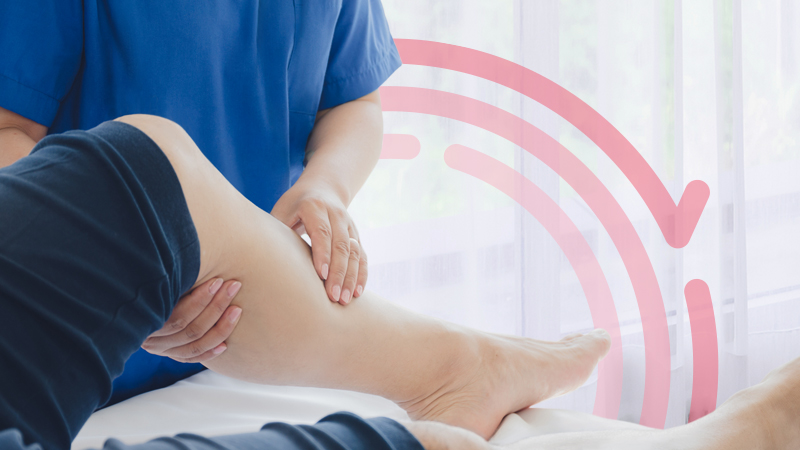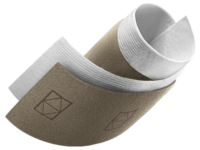Venous leg ulcers: How can you help patients’ wounds from coming back?
Learn why wounds recur and how to help patients manage this chronic disease.

When it comes to healing venous leg ulcers, one of the biggest challenges and frustrations for both patients and caregivers is the tendency for the wounds to recur. They may seem to be healed, but then develop again months or years later, whether treated conservatively or with surgery.¹
Why? Because the underlying chronic venous insufficiency is there for life, explains Cristine Ray, Medline Clinical Nurse Specialist-Acute Care. In other words, “There’s no magic wand for preventing leg ulcers from recurring,” she says.
It’s hard to determine exact statistics on how many venous ulcers recur, because there are many variables. But one multi-study analysis shows a rate as high as 40% recurring within the year and nearly 60% within three years.²
60%
of patients with a venous ulcer have a recurrence within three years²
But there are ways to help reduce this risk.
Reducing the chance that a chronic venous leg ulcer recurs has a lot to do with the individual patients and patient compliance. What are they capable of, able and willing to do outside of your care? And what do they need to know to help drive better outcomes?
To start, it’s important to understand some of the risk factors for recurrence.
Signs that a venous ulcer may recur
The more information you have about your patient’s condition and health history, the better you can plan their therapy. Although no consistent and agreed-upon tool currently exists to measure risk of recurrence,³ research on recurring venous ulcers does show some commonalities that you can use when treating your patients.
For instance, studies show that nearly 70% of people with these two factors have a recurrence within five years:4
- Limited ankle movement
- More than three previous ulcers
On the other hand, if patients had full ankle movement and only one previous ulcer, there was only a 26% rate of recurrence.4
Watch for these other patient risk factors that may indicate a wound may recur:1,5,6
- History of cardiac disease
- History of smoking
- Patients at risk of malnutrition
- Lower mobility
- Less activity after wound healing
- Slower initial wound healing, often seen in older patients
One more thing to consider: your patient’s mental health. Studies on other chronic conditions suggest a correlation between a person’s beliefs in their ability to cope with difficult demands in life.5 It’s something to think about when using your expert judgment to determine whether your patient may or may not follow their treatment plans at home.

The case for compression compliance
As you know, the standard treatment for venous wounds is compression. Your own experiences may tell you that compression can help reduce the risk of recurring venous leg ulcers, and research backs that up.
Here’s a statistic to drive that home to your patients: Studies found that for every additional day per week that people wore a Class 2 or 3 compression garment, the odds of recurrence were cut by almost 50%.5 Typically, the higher the degree of compression, the lower the recurrence rates.4
Choose the right compression therapy product for your patients.
However, compression is required as an ongoing, lifelong management strategy, and a patient’s adherence to that compression is crucial for success. Learn more about how to help patients comply with their compression therapy.
2 More ways to manage chronic venous disease
Besides the gold standard of compression, there are also other effective strategies that may help your patients manage their venous insufficiency.
1. Exercise
Venous stasis is associated with poor calf muscle pump function. Exercise has been shown to help improve muscle pump function, moving blood better through the leg veins so it doesn’t pool and cause ulcers.5
2. Leg elevation
Elevating the legs may enhance venous return. One study showed that participants who elevated their leg for an hour a day were 25 times less likely to get a recurring wound.5
When it comes to managing your patients’ venous stasis, help empower nursing staff to follow best practices with evidence-based education.
Key takeaway
Venous leg ulcers often recur due to many contributing factors, but there are ways you can help your patients reduce the risk. Know what to look for and some of the strategies to keeping venous ulcers from coming back. Compression is key, but other activities the patient can do at home include exercise and leg elevation.
Learn more about venous leg ulcers:
Venous leg ulcers: Explore evidence-based best practices to improve healing
Download this patient education handout
Why won’t chronic wounds heal? The answer is more than skin deep
Watch the webinar—Venous leg ulcers: One monster of a wound
References:
- Shenoy, M. (2014). Prevention of venous leg ulcer recurrence. Indian Dermatology Online Journal, 5(3), 386. Available at https://doi.org/10.4103/2229-5178.137824
- Reducing the Recurrence of Lower Extremity Wounds. (2020, September 3). WoundSource. Available at https://www.woundsource.com/blog/reducing-recurrence-lower-extremity-wounds
- Finlayson, K. J., Parker, C. N., Miller, C., Gibb, M., Kapp, S., Ogrin, R., Anderson, J., Coleman, K., Smith, D., & Edwards, H. E. (2018). Predicting the likelihood of venous leg ulcer recurrence: The diagnostic accuracy of a newly developed risk assessment tool. International Wound Journal, 15(5), 686–694. Available at https://doi.org/10.1111/iwj.12911
- Moneta, G. (2008). Prevention of recurrence of venous ulceration: Randomized controlled trial of class 2 and class 3 elastic compression. Yearbook of Vascular Surgery, 2008, 375. Available at https://doi.org/10.1016/s0749-4041(08)70937-0
- Finlayson, Kathleen J. and Edwards, Helen E. and Courtney, Mary D. (2009) Factors associated with recurrence of venous leg ulcers : a survey and retrospective chart review. International Journal of Nursing Studies, 46(8). pp. 1071-10
- Gohel, M., Taylor, M., Earnshaw, J., Heather, B., Poskitt, K., & Whyman, M. (2005). Risk Factors for Delayed Healing and Recurrence of Chronic Venous Leg Ulcers—An Analysis of 1324 Legs. European Journal of Vascular and Endovascular Surgery, 29(1), 74–77. Available at https://doi.org/10.1016/j.ejvs.2004.10.002
